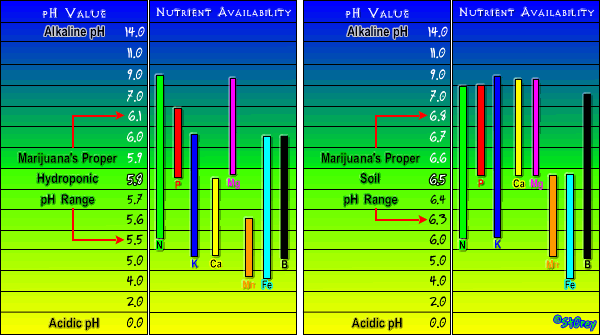Smart_Alec
New member
I hate to sound like a smart dummy but does the question here have to do with manipulating pH to make nutrients more or less available?
Basically it's because of nutrient availability. Calcium is available in the 5.8 range in hydro (comparable to coco) while it is almost above 6.5 in soil. Also there is a difference for the other nutrients as well. Here is a handy file that someone on this forum passed on to me.

if you are going to treat it like soil then you might as well stay in soil. You haven't told us your amendments. If you don't water coco everyday, the pH will rise. In your situation it sounds like you are better off mixing a bit of coco in your soil mix. not vice versa
If the PH of your medium isn't right then nutrients and minerals won't be absorbed by your plants as efficiently. You can feed your plants calmag all day but if your PH isn't right it wont be absorbed by your plants.
If you look up 'Cation exchange capacity' you will find info on how different mediums hold nutrient cations better at different PHs and why that occurs.
Coco interacts with nutrients and minerals quite a bit different then peat. The way it magnetically 'holds' nutrients within the medium is much more akin to hydroponics then soil. I think because of this you may find that if you amend coco with the exact same ratio's of organic matter as you would peat you may find you get some deficiencies.
I believe verdantgreen made a comment on how he found adding coco to his organic mix threw things a little out of whack. Something to do with how coco interacts with phosphorus and this rang true to me because many Coco specific nutrients have lowered levels of phosphorus available in them due to coco's unique nutrient holding capacities.
but, if you dont add organics too the coco you can treat it just like hydro ph, and feedwise once you have enough roots.
when it came to flowering phase it didn't work so well.
I pop my seeds in rockwool cubes and immediatly when they are coming up, I put seedlings to 6 liter pots with 30% of hydro rocks and 70% coco. From day 1 (24h light) i set drippers to water 4 times a day. After 10 days i switch 12/12 and set drippers to water 3 - 4 times a day. They grow like weed from hellNever veg more than 10-14 days. Why to wait for enough roots? I treat coco like hydro from day 1 and plants love it.
Ah... I don't think we disagree at all.IF, funny we disagree, I think it will work fine
Specifically, when I said this:over the years there have been a couple of members that wanted to use coco with all organic amendments and teas and while most of them seemed to have some success for the veg phase, when it came to flowering phase it didn't work so well.
I could have expanded more. In instances where proven recipes for amended-water-only-soil-organics substitute various grades of coco for the peat and vermiculite, the plants were starved early into flower.a conventional amendment content subbing out coco for peat has shown to be inadequate feed through late flower.
There are a number of reasons why this might have been the case.I'm not trying to explain why this is the case, just acknowledge that the same quantity of amendments don't have the same results when the base material transitions from peat to coco.
In instances where proven recipes for amended-water-only-soil-organics substitute various grades of coco for the peat and vermiculite, the plants were starved early into flower.
pinecone I think coco holds microorganisms as good as peat.
Very mysterious PVC pipe.
My concern with straight coco (especially the Botanicare long sieve variety) is that it would not be that well suited to host the type of bacterial populations that you need to make a semi-organic grow work. Generally speaking bacteria have a hard time processing brown type ligneous material - which coco is. Such material typically favors fungi, at least initially.
Anyway if you are going to try this it seems like you would want both inoculate the coco with bacteria and find a way to maintain that bacterial population. For inoculation you can use a compost tea. A green mulch (grass clippings, weeds, bubble hash leavings, fresh male plants, ect) would be helpful in maintaining the bacterial population and also in retaining moisture.
Pine